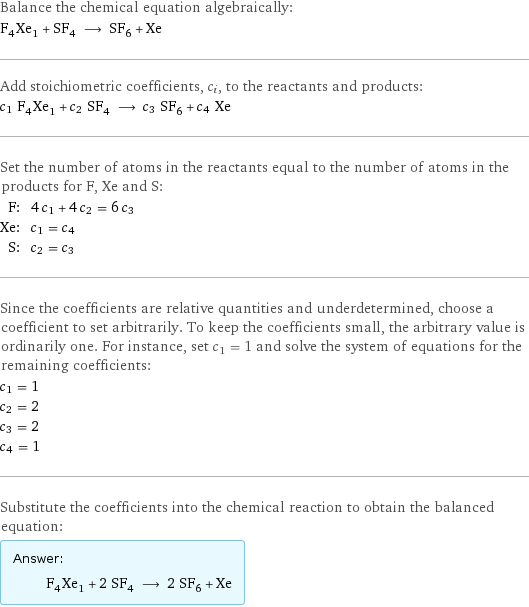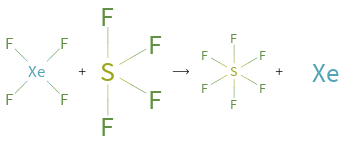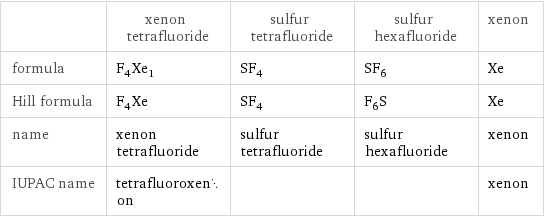Input interpretation

F_4Xe_1 xenon tetrafluoride + SF_4 sulfur tetrafluoride ⟶ SF_6 sulfur hexafluoride + Xe xenon
Balanced equation

Balance the chemical equation algebraically: F_4Xe_1 + SF_4 ⟶ SF_6 + Xe Add stoichiometric coefficients, c_i, to the reactants and products: c_1 F_4Xe_1 + c_2 SF_4 ⟶ c_3 SF_6 + c_4 Xe Set the number of atoms in the reactants equal to the number of atoms in the products for F, Xe and S: F: | 4 c_1 + 4 c_2 = 6 c_3 Xe: | c_1 = c_4 S: | c_2 = c_3 Since the coefficients are relative quantities and underdetermined, choose a coefficient to set arbitrarily. To keep the coefficients small, the arbitrary value is ordinarily one. For instance, set c_1 = 1 and solve the system of equations for the remaining coefficients: c_1 = 1 c_2 = 2 c_3 = 2 c_4 = 1 Substitute the coefficients into the chemical reaction to obtain the balanced equation: Answer: | | F_4Xe_1 + 2 SF_4 ⟶ 2 SF_6 + Xe
Structures

+ ⟶ +
Names

xenon tetrafluoride + sulfur tetrafluoride ⟶ sulfur hexafluoride + xenon
Equilibrium constant
![K_c = ([SF6]^2 [Xe])/([F4Xe1] [SF4]^2)](../image_source/7afeff5110b0b12a663a836360788125.png)
K_c = ([SF6]^2 [Xe])/([F4Xe1] [SF4]^2)
Rate of reaction
![rate = -(Δ[F4Xe1])/(Δt) = -1/2 (Δ[SF4])/(Δt) = 1/2 (Δ[SF6])/(Δt) = (Δ[Xe])/(Δt) (assuming constant volume and no accumulation of intermediates or side products)](../image_source/a75bbf66532322742dd3a042e1b7b6db.png)
rate = -(Δ[F4Xe1])/(Δt) = -1/2 (Δ[SF4])/(Δt) = 1/2 (Δ[SF6])/(Δt) = (Δ[Xe])/(Δt) (assuming constant volume and no accumulation of intermediates or side products)
Chemical names and formulas

| xenon tetrafluoride | sulfur tetrafluoride | sulfur hexafluoride | xenon formula | F_4Xe_1 | SF_4 | SF_6 | Xe Hill formula | F_4Xe | SF_4 | F_6S | Xe name | xenon tetrafluoride | sulfur tetrafluoride | sulfur hexafluoride | xenon IUPAC name | tetrafluoroxenon | | | xenon